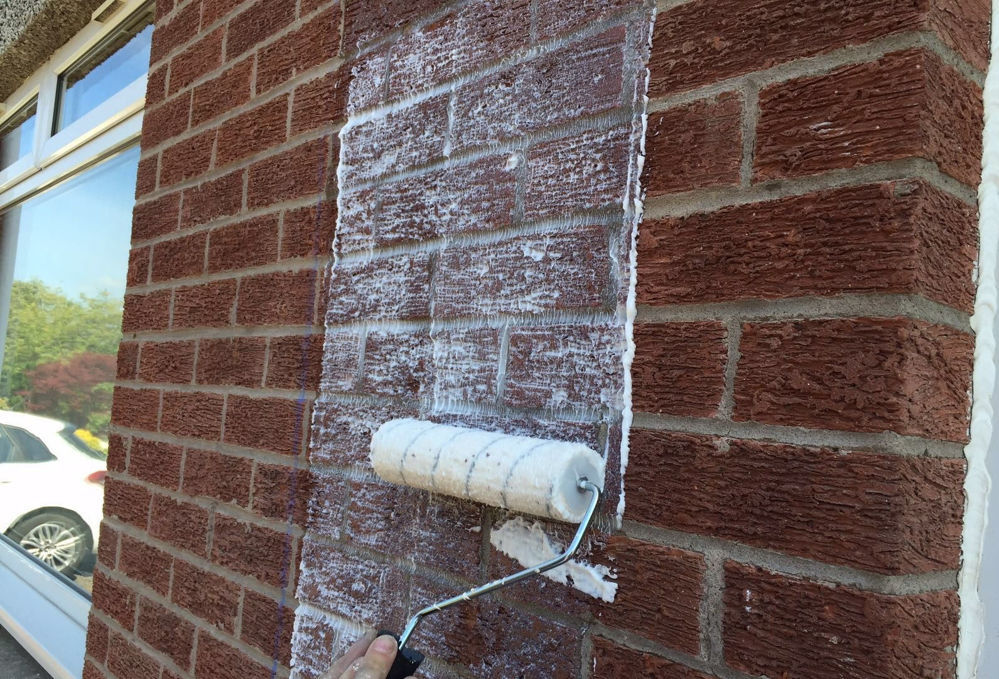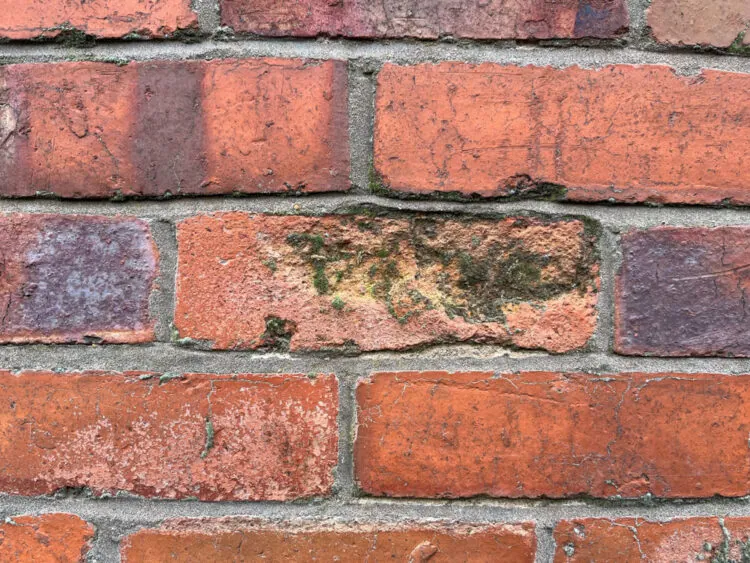Everything You Need To Know About Masonry & Brick Sealers
Brick sealers have been used for decades to waterproof exterior walls, but you may be wondering what they do, how they work and whether they are the right choice for your home.
Our Technical Team, with an average of over 25 years experience in building protection, have put together this complete guide to brick sealers so you can find out everything you need to know in one place.
In this guide, we’ll cover:
- What brick sealers are and how they work
- Why breathability is the most important thing for your home
- How sealers compare to other options
- The best ways to protect your bricks and masonry from damage
What Is A Brick Sealer?
Brick sealers, sometimes called brick sealants or masonry sealers are waterproof coatings designed to stop rainwater from soaking into brick, stone or concrete walls.
They work by forming a thin, invisible film on the surface of masonry that blocks water absorption. This approach became common in the 1980’s as homeowners looked for ways to prevent damp and improve the durability of bare masonry.
Why Homeowners Use Brick Sealers
You may be thinking, why does a brick need to be protected, surely they are already waterproof?
The truth is, natural mineral surfaces like brick and stone are porous, meaning they absorb moisture. When this happens, it can lead to several common problems.
1. DAMP
When the moisture soaks into the exterior wall, it can be transferred through to the internal wall of your home.
Homes with a solid wall construction have one continuous wall, meaning moisture that enters the external side can soak through into the internal walls of your home, leading to damp.
With a cavity wall construction, there is a gap between the inner and outer wall. If that cavity is filled with poorly fitted insulation, debris or mortar covered wall ties, it removes the gap and allows moisture to bridge across into the home.
This transfer of moisture is called penetrating damp and can damage plaster and paint but can also encourage black mould growth.
Learn more: A full guide to penetrating damp
2. STRUCTURAL DAMAGE
Moisture can cause substantial damage to external walls if allowed to penetrate. When the water enters into the brick it can undergo a freeze-thaw cycle, which will cause it to expand by up to 9%.
Once this water expands, it applies pressure on the surface of the brick, causing ‘spalling’. This spalling results in the brick cracking or flaking away at the surface which allows more moisture to absorb into the wall.
This water ingress will eventually result in blown brick faces and large sections of the masonry crumbling, leading to costly repairs.
3. APPEARANCE
Away from the deterioration of building’s materials, moisture entering an exterior wall will impact the kerb appeal of your home.
Along with the wear and tear to the bricks that cracking or spalling will cause, the moisture will lead to other problems like discolouration and green growth, which thrives in the moist conditions on a wet exterior wall.
Salt efflorescence is another visible knock-on effect of moisture in exterior walls. It appears as a white, powdery deposit on brick, stone or concrete surfaces. When water enters the masonry it dissolves natural salts within the materials. As the water evaporates, these salts are left on the surface.
While not structurally harmful, it shows moisture is being absorbed into the wall and can impact the aesthetic appeal of the brickwork.
Should You Use A Brick Sealer?
At first, a brick sealer sounds like the perfect solution. A clear, protective coating that stops rain from soaking into your walls and causing damage. The problem is, traditional sealers can cause more problems than they solve.
The term sealer or sealant refers to a product that ‘seals’ a surface, preventing moisture from entering.
A sealer works by forming a thin film over the surface of the brick. While this layer blocks water from getting in, it also blocks moisture from getting out.
Bricks need to breathe because moisture naturally builds up underneath the surface from within the building. If the surface is sealed, this moisture is trapped inside the wall. Over time, trapped moisture forces its way out, causing the coating to break.
As advised by the Society for the Protection of Ancient Buildings (SPAB), anything that prevents the evaporation of moisture from walls will lead to decay.
This sealing of the surface can also worsen damp problems. Condensation and internal humidity have nowhere to escape, resulting in wet walls, damp patches, bubbling paint and mould inside the home.
To avoid this, any coating must be highly breathable. Breathability is measured using an SD value, the lower the value, the better the breathability. To be considered breathable, a coating should have an SD value of 0.5, but in practice, it should be much lower. Even a small restriction in breathability can trap moisture within the wall.
Learn more: The science behind breathability
What Should You Use Instead?
If you would like to protect exterior bricks, you need a coating that reduces water absorption without restricting breathability. Traditional brick sealers and standard masonry paints struggle to achieve this balance.
Sealers often trap moisture beneath the surface film, while many paints still absorb rainwater and limit breathability at the same time. Both increase the risk of damp and eventually peeling once the moisture causes the coating to fail.
Cutting-edge developments in technology have solved this problem. Instead of sealing the surface, nano-technology chemically bonds to the surface rather than sitting on top of it.
This creates a super hydrophobic surface that repels rain, forcing water to bead and roll off before it can soak into exterior walls. At the same time, the surface remains highly breathable thanks to an open-pore structure that maintains the path for water vapour to pass through.
This technology is used in two products:
- Emperor Masonry Creme – a clear treatment that provides invisible protection for bare brick, stone and render.
- Emperor Masonry Paint – a coloured finish that offers the same performance for bare and previously painted walls.
Many products claim to protect brick walls from damp, but few have the evidence to show it.
An independent UKAS accredited laboratory assessed how this nano-technology performs under long-term weather exposure. The tests replicated 25 years of harsh weathering, measuring water absorption, breathability, durability and thermal performance.
The results showed:
- No deterioration in appearance or performance after 25 years of testing
- Water absorption reduced by up to 96.3%.
- Treated walls stayed 6°C warmer than untreated walls on average.
- Breathability was maintained, with SD values of 0.01 and 0.03.
Although Emperor Masonry Creme and Emperor Masonry Paint demonstrated to have a 25 year performance, they showed no signs of deterioration after this time. That’s why they come with a lifetime guarantee, for complete peace of mind.
How To Protect Bricks
While both Emperor Masonry Paint and Emperor Masonry Creme use the same technology, if your goal is to protect bare brick, stone or render while keeping its natural look, Emperor Masonry Creme is the right choice.
YOU WILL NEED:
- Emperor Masonry Creme
- Emperor Exterior Cleaner
- A long-pile roller
- Paint brush
- Paint tray
- Sandpaper
- Dust sheets
- Masking tape
1. PREPARATION
Based on decades of testing and field application, we’ve found that preparing the wall properly has a significant impact on the performance and appearance of the wall long-term.
Start by cleaning the surface to remove dirt, moss or efflorescence. If any paint is present, remove it completely.
While ensuring the surface is dry, apply the Emperor Exterior Cleaner. This is an anti-fungal cleaner that removes moss and algae from the wall.
Inspect the brickwork to see if there are any cracks or holes and repair them with an exterior filler.
2. APPLICATION
Once the surface is clean and sound, apply one coat of Emperor Masonry Creme.
Choose a dry day where temperatures are above 5°C to give the treatment time to absorb into the brick properly.
You can apply Emperor Masonry Creme using a brush, roller or a spray machine depending on your preference. The cream has a thick, gel-like texture that is closer to moisturiser than paint. As you spread it across the wall, it soaks in rather than sitting on the surface, so don’t try to roll it into the wall. Simply roll it on and leave it to work its magic.
You are aiming to achieve an even coating that is predominantly white, but you can still see parts of the brick underneath.
Leave the wall to dry for 1-2 hours until it is fully soaked into the wall, which can take longer in colder conditions. Once dry, your wall will look completely natural but will now repel rainwater away from your home.
Frequently Asked Questions
Is sealing bricks a good idea?
Sealing bricks can do more harm than good. If a product seals, it increases the risk of damp, spalling and mould.
The better alternative is using a product that is both able to reduce water absorption and remain highly breathable like Emperor Masonry Creme.
Instead of sealing the surface, it keeps rain out while remaining highly breathable. With the UK facing wetter weather, protecting exterior walls from wind-driven rain is a smart investment for future-proofing your home.
What surfaces can Emperor Masonry Creme be applied to?
Emperor Masonry Creme can be applied to any mineral substrate. This means whether it is brick, stone, concrete, sandstone, limestone or mortar, the treatment will be able to penetrate and protect the material.
Does it leave a finish?
Emperor Masonry Creme does not alter the appearance of masonry at all. Some brick sealants create a sheen on the surface, which is not the case with this product because it does not form any surface film that can impact the appearance of bricks.
Can you paint over bricks sealers?
In no way should you mix a clear product like Emperor Masonry Paint or a traditional sealer with paint.
These are designed to repel water, so do not allow paint to stick to the surface. In the same way, you cannot apply them over the top of paint as it must be able to penetrate into the brick.
If you want to protect bricks and create a coloured finish, use Emperor Masonry Paint instead.
How do you seal crumbling bricks?
If your bricks are damaged or flaking, you must repair them first before applying anything to the wall. Once the surface is sound, you can then apply Emperor Masonry Creme to help prevent future damage.
If you have more questions, we are here to help with our in-house team of experts. Contact us at [email protected] to get expert advice tailored to your home.
Ready to start? Take our handy quiz to get personalised recommendations and find the right products for your project in a few clicks.
Want to see the difference for yourself? Order your sample of Emperor Masonry Creme and test it on your own walls before you begin.
This article was written by the Emperor Technical Team, a group of experts with an average of over 25 years experience in the building industry. They work daily with homeowners, tradespeople and specification professionals to deliver practical, expert guidance that promotes long-term results, supports wall health and helps create homes that are prepared for the future.













